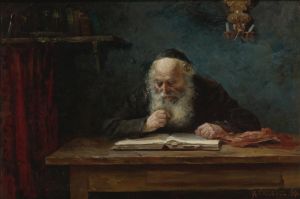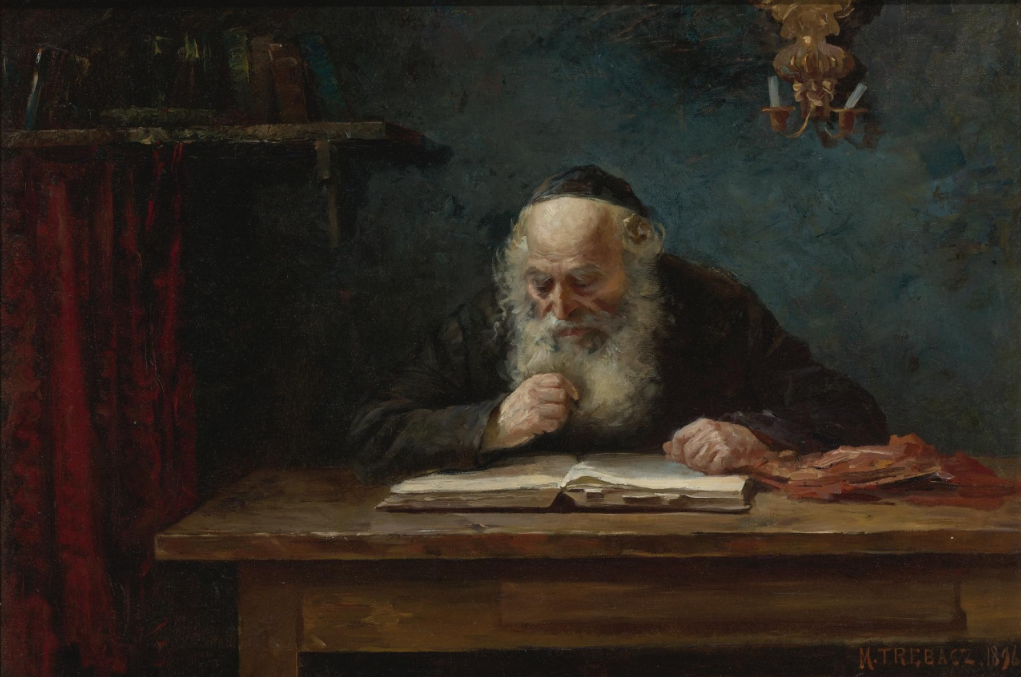
BS”D
Volume 39, No. 21
15 Adar 5785
March 15, 2025
In this week’s Parashah, Moshe Rabbeinu descends from Har Sinai with the Luchot, only to break them when he sees Bnei Yisrael dancing before the Golden Calf. Moshe’s action was not impulsive. Rather, the Gemara (Shabbat 87a) explains that Moshe reasoned as follows: The Torah (Shmot 12:43) says that an apostate may not eat from the Korban Pesach, which is only one of the Mitzvot. Certainly, then / Kal va’chomer, Bnei Yisrael are presently unworthy of receiving the Luchot, which represent all of the Mitzvot! [Until here from the Gemara]
R’ Aharon David Goldberg shlita (Rosh Hayeshiva of the Telshe Yeshiva in Cleveland, Ohio) writes: A “Kal va’chomer” is one of the tools that Hashem has given us with which to interpret the Torah. Thus, if a Kal va’chomer led Moshe to conclude that he had to break the Luchot, that means that it was the Torah’s will that he do so. Indeed, the Gemara records that Hashem complimented Moshe on his decision. Moshe could have pondered all the negative consequences that would result from breaking the Luchot, but he did not do so. Instead, he nullified his own judgment and did what he understood the Torah to require.
We read in Melachim II (ch.20) that the righteous king Chizkiyah was told by the prophet that he deserved to die because he failed to marry and have children. Chizkiyah defended himself, saying that he saw through Ruach Ha’kodesh that he would have a son who was wicked, and he did not wish to have such a son. R’ Goldberg observes: Chizkiyah was right; he did ultimately have a son, King Menashe, whose wickedness sealed the fate of the Bet Hamikdash. Nevertheless, the prophet teaches, that was none of Chizkiyah’s business. His job was to observe the Mitzvot without question, including the Mitzvah to marry and procreate. (U’vacharta Va’chaim Al Nefesh Ha’chaim p.390)
********
“Make Your way known to me . . .” (33:13)
In response to this request by Moshe, Hashem taught him the Thirteen Attributes of Mercy (see below). R’ Naftali Hertz Weisel z”l (1725-1805; German banker, and prolific author of works of Torah commentary, Hebrew grammar, and Mussar) explains that Moshe made this request because we are commanded (Devarim 11:22), “To walk in all His ways.” R’ Weisel notes: The Torah expressly commands us to walk in “all” Hashem’s ways, which includes both His ways that are stated expressly in the Torah and those that are only implied. It also includes Hashem’s punitive ways. “But great understanding is needed to properly understand Hashem’s ways,” R’ Weisel cautions, for they are “the secrets of the Torah and the depths of wisdom.” (Ru’ach Chen 12:19, p.448)
********
“He said, ‘Show me now Your glory’.” (33:18)
When Hashem first appeared to Moshe (Shmot 3:6), “Moshe hid his face, for he was afraid to gaze toward the Elokim.” R’ Yaakov Moshe Charlap z”l (1882-1951; rabbi of Yerushalayim’s Sha’arei Chessed neighborhood and Rosh Yeshiva of Yeshivat Mercaz Harav) writes: Moshe was afraid to look lest he mistakenly conclude that what was revealed to him then was all that there was to be revealed. He preferred to remain a “seeker of wisdom” than to be a “wise man.” Therefore, he merited to “gaze at the image of Hashem” (Bemidbar 12:8). Even in our verse, Moshe did not make his request for the sake of knowledge, but only to come closer to Hashem by increasing his level of understanding. (Mei Marom: Nimukei Mikra’ot, Shmot 3:6)
********
“Hashem, Hashem, Kel, Compassionate and Gracious, Slow to Anger, and Abundant in Kindness, and Truth; Preserver of Kindness for thousands of generations, Forgiver of iniquity, Willful Sin, and Error, Ve’nakeh / and Who Cleanses–Lo ye’nakeh / but does not cleanse completely . . .” (34:6-7)
R’ David Moskowitz z”l (early 20th century; Nasaud, Romania) asks: These verses list G-d’s “Thirteen Attributes of Mercy,” but does “Lo ye’nakeh/ does not cleanse completely” indicate mercy? (Indeed, many commentaries simply omit this phrase from their lists.)
He answers: We read (Yirmiyah 46:28), “You, do not be afraid, My servant Yaakov–the words of Hashem–for I am with you; though I shall make an end of all the nations where I have scattered you, I shall not make an end of you; I shall punish you with justice, but Lo anakekah / I shall not destroy you completely.” Given the shared root of “Anakekah” and “Ye’nakeh,” we can understand the phrase “Nakeh Lo ye’nakeh” to have a similar meaning: “He will wipe away [your sins], but He will not wipe [you] away.” Read this way, “Lo ye’nakeh” also indicates G-d’s mercy.
R’ Moskowitz continues: With this we can understand an obscure comment by R’ Yitzchak Luria z”l (“Arizal”; 1534-1572) regarding the phrase we are discussing. He says (based on Pirkei Avot ch.4), “Do not look at the Kankan / pitcher, but at what is in it.” R’ Moskowitz explains: “Kankan” is spelled Kuf-nun-kuf-nun. When those letters are removed from the words “Ve’nakeh ye’nakeh” (in accordance with the instruction, “Do not look at the Kankan”), the remaining letters (i.e., “what is in it”) are the four letters of G-d’s Name (which we refer to as “Y-K-V-K”). This Divine Name is itself one of the Attributes of Mercy in our verse. “Why will I not wipe you away?” Hashem is saying. “Because My Name is in your midst,” as Yirmiyahu says, “For I am with you.”
R’ Moskowitz adds: This is the meaning, also, of the line in Ma’oz Tzur,“From the remnants of the Kankanim a miracle was done . . .” The author is indicating that the Chanukah miracle came about through Hashem’s Attribute of Mercy–the “remnant of Kankan,” as explained above. (Gelilei Zahav: Mikeitz)
********
“He said, ‘Behold! I seal a covenant: Before your entire people I shall do wonders such as have never been created in the entire world and among all the nations, and the entire people among whom you are will see the work of Hashem– which is awesome–that I am about to do with you’.” (34:10)
R’ Nosson Yehuda Leib Mintzberg z”l (1943-2018; rabbi and Rosh Yeshiva in Yerushalayim and Bet Shemesh, Israel) writes: Commentaries, including R’ Moshe ben Nachman z”l (Ramban; 1194-1270; Spain and Eretz Yisrael), struggle to understand this verse, for we do not seem to find “wonders such as have never been created in the entire world and among all the nations” at any point in Jewish history after the Exodus!
R’ Mintzberg suggests: “You,” in the phrase, “That I am about to do with you,” is in the singular form, and refers to Moshe Rabbeinu. Hashem is telling Moshe in this verse: “When Bnei Yisrael enter Eretz Yisrael under your leadership, they will experience wonders, in your merit, such as the world has never seen.” Unfortunately, however, Moshe did not enter Eretz Yisrael, so the prophesied wonders did not occur. Still, Midrash Kohelet Rabbah teaches, “Like the first redeemer, so the last redeemer,” and, therefore, we await the fulfillment of this prophecy at the time of the future redemption.
Alternatively, R’ Mintzberg writes, the wonders referred to in our verse are the wonders that have allowed the Jewish People to survive 2,000 years of exile. Surely, it is the most wondrous thing that all of the persecutions and all the attempts by powerful empires to destroy us have not succeeded. R’ Yaakov Emden z”l (1697-1776; Central Europe) writes: “Our position in the world is like a scattered flock of sheep. How many are our enemies! How powerful are those who rose up against us since our [nation’s] youth! But they could not destroy or eliminate us. I swear! When I look at these wonders, they are greater in my view than all of the miracles and wonders that Hashem did for our ancestors in Egypt, the desert, and Eretz Yisrael! The longer the exile continues, the more true this is proven to be.” (Ben Melech: Galut U’geulah p. 511)
********
Purim
The Gemara (Megillah 5b) relates that Mordechai wanted to establish Purim as a Yom Tov, a festival on which work is forbidden, but the Jewish People did not agree. What was behind the differing opinions of Mordechai and his contemporaries?
R’ Moshe Sofer z”l (1762–1839; rabbi and Rosh Yeshiva in Pressburg, Hungary) explains: The Purim story occurred near the end of the 70-year exile between the destruction of the first Bet Hamikdash and the construction of the second Bet Hamikdash. Mordechai believed that when the time would come to build the Second Temple, the Jewish People would make Aliyah en masse and would never again be subjugated by a gentile nation. As such, Haman’s defeat was the beginning of the permanent redemption, Mordechai believed, and it was appropriate, he thought, to mark that occasion with a Yom Tov.
Unfortunately, the Jewish People disappointed Mordechai and only about 40,000 of them returned to Eretz Yisrael. And, throughout the era of the second Bet Hamikdash, the Jewish People were subjugated by either Greece or Rome. Given this, there was no reason to establish a new Yom Tov, and the Jewish People did not agree to do so, R’ Sofer writes.
He adds: In light of this, we can understand why Mordechai chose having a wall in the days of Yehoshua bin Nun, the leader who first conquered Eretz Yisrael, as the factor that determines whether a city observes Purim on a separate day–what we call “Shushan Purim.” Mordechai expected that the Jewish People would soon be resettling in Eretz Yisrael and that the majority of them would make their homes in the major cities, most of which were walled in Yehoshua’s time. He intended that most Jews would observe Purim on the fifteenth of Adar, since that was the day when the Jews in Shushan rested. Only a minority of Jews were meant to observe Purim on the day before, so that they would be free on “Shushan Purim” to bring fresh food to the city-dwellers. As noted, however, the Jewish People of Mordechai’s time did not share his vision, and thus nearly all Jews observe Purim on the fourteenth. (Derashot Chatam Sofer p.202a)


